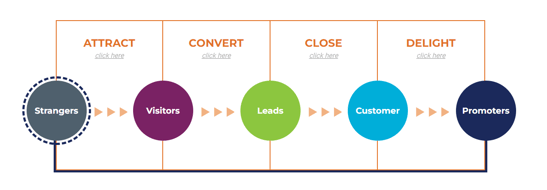Table of Contents
More Glossary Articles
Inbound marketing is a technique that allows brands to capture the attention of their audience and generate leads and customers for a business by using tactics such as content marketing, social media marketing, and SEO. The focus of inbound marketing is to connect to those people who would be the best customers for a brand and deliver helpful content in order to start building a relationship with them.
Unlike Outbound marketing, which relies on methods which customers see as a distraction, such as advertising and cold calling, Inbound is effective because its intended audience perceives the marketing messaging as useful and helpful content.
Why Inbound Marketing works?
People are bombarded by all kinds of marketing messaging all day long. This is so overwhelming that most people have become oblivious to all the advertising that surrounds us. To get a sense of how ineffective traditional marketing is, consider some of the following statistics:
- 44% of direct mail never gets opened.
- 86% of people skip through TV commercials
- 84% of 25-34 year olds have abandoned a website because of an annoying ad
Inbound turns the table on the whole model of bombarding people with messages in the hope that one sticks. Instead, inbound marketers focus their efforts on empowering their audience to discover their brands by providing high-quality information on the topics they’re interested in.
Inbound’s effectiveness can be explained by the fact that it follows the audience at every step of the journey from not knowing a brand to being its loyal customer. A central feature which captures this approach is the inbound funnel.
The Inbound Marketing Funnel
The inbound funnel is a graphic representation of the steps a person takes to become a customer of a brand. It allows marketers to follow and serve their audience in each stage of the funnel and help them move to the next step through relevant content and other marketing tactics.
The inbound funnel has 4 main stages:
- Visitor
- Subscriber
- Prospect
- Customer

In each stage, inbound marketers use a set of tools and tactics to achieve a specific goal and move audience members to the next step in the process.
Attracting Visitors
The first stage in the funnel is to generate visitors for your website. To do this, inbound marketers use a mix of tactics that allow them to reach the audience that can benefit from the solution they’re selling.
Blogging and search engine optimization allows marketers to generate targeted organic traffic that builds up over time, while social media helps with brand building and driving visitors to the website with more lighthearted content.
Converting Subscribers
The large majority of the people who visit your website will never become customers. Still, Inbound marketing can be effective if you manage to generate enough customers from the small share who do. The first step in that process is getting as many of your occasional visitors to become loyal followers of the content you’re publishing. To do this, you have to get people on your email list.
The most effective way to achieve this is by offering your readers additional content (also called a content upgrade) related to the topics you know they’re interested in and asking for their email addresses in exchange.
You see this tactic in practice when you search for a term like SEO checklist and you find an article that offers a downloadable PDF as a content upgrade. Source
Optin forms are the other essential element in this process. Some brands use extensive forms that help them generate complete customer profiles, while other rely on simple popups that ask only for email address. The benefit of the latter approach is that is creates very little friction for readers and maximizes the chance that they convert.
Tools like OptinMonster and Sumo make it easy to set up such optins and start collecting emails for your list.
Nurturing Prospects
The people on your email list form a pool of prospective customers for your business. Inbound marketing gives you a number of potential techniques you can use to find and nurture the best prospects within your subscriber base.
Sending out email campaigns is one way to keep in touch and educate your prospective customers. By tracking and analyzing the behavior of the people who are receiving your emails, you can understand which subscribers are well-positioned to take advantage of your product and get a feeling for the right moment to pitch it to them.
A number of email marketing tools allow you to score prospects and focus your attention on those who are most likely to become long-term users of your product. Drip is just one example of a tool that offers lead scoring capabilities.
Closing Customers
Turning your audience into loyal customers is the final stage in the funnel. In this stage, inbound marketers use a combination of content that’s relevant to prospects in this phase and marketing automation to deliver it in the best possible time and context.
Some content types you can see used in this stage are case studies, price lists, and comparisons between the products of different vendors. Platforms like Drip and Campaign Monitor allow marketers to easily set up and execute automation campaigns delivered over email, social media, and other channels.


